Understanding Electric Energy
Firstly, in today’s modern world, electric energy powers almost every aspect of our lives. So, from the simple light bulb illuminating our rooms to complex machinery in industries, electric energy is the driving force behind them. But what exactly is electric energy? How is it produced, and why is it so crucial to our daily lives? Furthermore, this article aims to shed light on these questions and delve deeper into the fascinating realm of electric energy.
What is Electric Energy?
Electric energy, at its core, is the energy derived from the movement of charged particles. Primarily electrons. However, it’s a secondary energy source. Meaning it’s derived from the conversion of other sources of energy. Such as fossil fuels, solar energy, or wind energy.
The Basics of Electric Energy
- Electric Field and Electric Current: An electric field is a region around a charged particle where other charges experience a force. The flow of electric charge through a conductor, such as a copper wire, is termed as electric current.
- Potential Difference: Often referred to as voltage, it’s the driving force that pushes the current through circuits. It’s the difference in electrical potential energy between two points in a circuit.
- Static vs. Current Electricity: Static electricity is the accumulation of charge on surfaces. While current electricity involves the flow of electrons from one part of a circuit to another.
How is Electric Energy Produced?

Electric energy is generated through various means. With power plants playing a pivotal role. Thus, these plants convert primary sources of energy, like nuclear energy or natural gas, into electric power.
Different Forms of Energy Conversion
- Fossil Fuels: Power plants often burn fossil fuels, such as coal or natural gas, to produce electricity. In fact the combustion releases energy, which turns water into steam, driving a turbine connected to an electric generator.
- Nuclear Energy: In nuclear power plants, atomic nuclei split apart in a controlled chemical reaction. This process releases a tremendous amount of energy in the form of heat. Which is then converted into electric energy.
- Renewable Sources: Solar panels capture sunlight and convert it into electricity. Wind turbines, on the other hand, use the wind’s mechanical energy to generate electric power.
Why is Electric Energy Essential?
Electric energy has revolutionized the way we live, work, and play. As a result it powers electrical appliances, electronic devices, and even electric vehicles, making our lives more comfortable and efficient.
Applications of Electric Energy
- Household Use: From lighting up homes with light bulbs to running electrical appliances, electric energy is omnipresent in our daily lives.
- Industrial Use: Industries rely heavily on electric motors and machinery to manufacture products.
- Transportation: Electric vehicles are becoming increasingly popular, offering a cleaner alternative to fossil fuel-powered vehicles.
FAQ’s
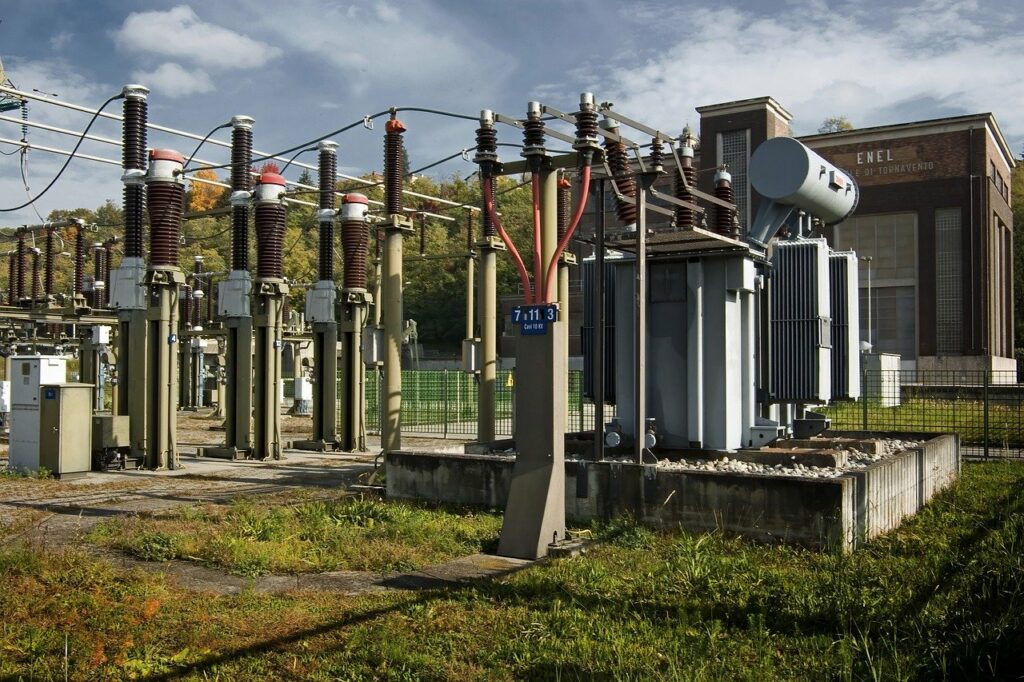
How does electric energy differ from other forms of energy?
Firstly electric energy is a form of energy that results from the movement of electric charges, typically electrons. It differs from other forms of energy in several ways:
- Nature: Electric energy is a secondary energy form. Meaning it is usually generated from other primary energy sources. Like fossil fuels, nuclear energy, or renewable sources. In contrast, other forms of energy, such as thermal (heat), mechanical (kinetic), chemical, or nuclear energy, can exist independently.
- Transportability: Electric energy is highly transportable, thanks to electrical grids and wiring systems. Thus, this makes it convenient for distributing energy over long distances to power homes, industries, and devices. In contrast, some forms of energy, like heat or mechanical energy, are less easily transported.
- Conversion Efficiency: Electric energy can be converted into other forms of energy. Relatively efficiently and vice versa. For example, electric energy can be converted into mechanical energy. In an electric motor or into heat in an electric heater.
- Applications: Electric energy is versatile and used in a wide range of applications. From lighting and electronics to transportation and industrial processes. Also other forms of energy have more specific applications; for instance, thermal energy is primarily used for heating. While mechanical energy is common in machinery.
What role did pioneers like Thomas Edison and Michael Faraday play in the field of electric energy?
- Thomas Edison: Thomas Edison was a prominent inventor and entrepreneur in the late 19th and early 20th centuries. Additionally he played a crucial role in the development of electric power systems. Also, Edison is best known for inventing the practical incandescent light bulb. And the electric power distribution system that used direct current (DC). While his DC system was widely used for a time. It was eventually supplanted by Nikola Tesla and George Westinghouse’s alternating current (AC) system. Which was more efficient for long-distance power transmission.
- Michael Faraday: Michael Faraday was a pioneering scientist in the 19th century. Who made significant contributions to the understanding of electromagnetism and electrochemistry. Significantly he formulated Faraday’s laws of electromagnetic induction, which laid the foundation for the generation of electric energy through the rotation of a magnet within a coil of wire. In fact this principle is fundamental to the operation of electric generators, which are key components of power plants and electricity generation systems.
How do electric fields contribute to the generation of electric energy?
Electric fields play a crucial role in the generation of electric energy through electromagnetic induction. When a magnetic field within a coil of wire changes, it induces an electric field, which in turn generates an electric current in the wire. This phenomenon is described by Faraday’s law of electromagnetic induction.
Electric generators, such as those used in power plants, utilize this principle. Additionally they consist of coils of wire (typically copper). That are rotated within a magnetic field. As a result the coils move relative to the magnetic field. The magnetic flux through the coils changes, inducing an electric current. This current can then be harnessed as electric energy. And subsequently transmitted and used to power various devices and systems.
Why are renewable sources of energy considered more sustainable for electric energy production?
Renewable sources of energy, such as solar, wind, hydroelectric, and geothermal power, are considered more sustainable for electric energy production for several reasons:
- Reduced Environmental Impact: Renewable energy sources produce little to no direct greenhouse gas emissions or air pollutants when generating electricity. This is in contrast to fossil fuels, which release carbon dioxide and other pollutants when burned for energy. Reducing these emissions is crucial for mitigating climate change and improving air quality.
- Inexhaustibility: Unlike finite fossil fuel resources, renewable sources are essentially inexhaustible. They rely on naturally occurring processes, such as sunlight, wind, and water cycles, which are sustainable over geological time scales.
- Energy Security: By diversifying energy sources and reducing dependence on fossil fuels, countries can enhance their energy security. And reduce vulnerability to supply disruptions and price fluctuations in global energy markets.
- Job Creation and Economic Growth: The renewable energy sector has the potential to create jobs and stimulate economic growth. Also investments in renewable energy technologies can lead to the development of new industries and markets.
- Technological Advancements: Continued research and development in renewable energy technologies can lead to technological advancements, making these sources more efficient and cost-effective over time.
- Local Energy Production: Many renewable energy systems can be deployed locally or regionally. In fact reducing the need for long-distance energy transmission and associated energy losses.
Overall, the sustainability of renewable energy sources makes them an attractive choice for reducing environmental impacts, increasing energy resilience, and transitioning toward a more environmentally friendly and secure energy future.
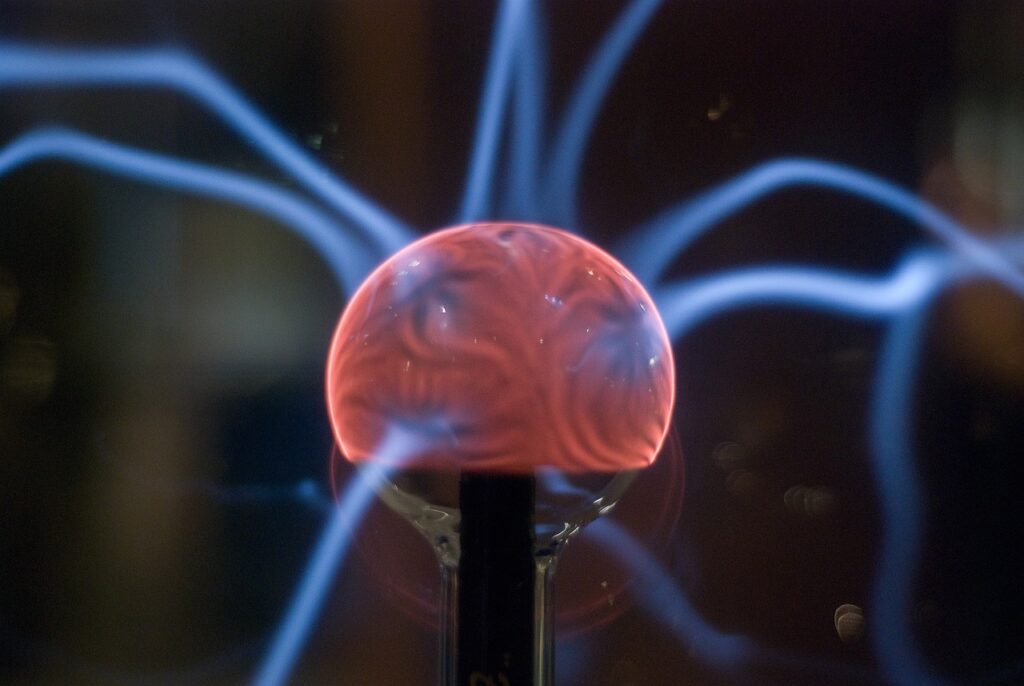
Conclusion
Electric energy, with its myriad applications and significance, is undeniably a cornerstone of modern civilization. Understanding its basics, production methods, and importance can help us appreciate the marvels of electricity and the comforts it brings to our lives.
Fact: Thomas Edison, often dubbed the “father of electric light,” wasn’t the actual inventor of the light bulb. However, he did develop the first commercially viable incandescent light. [Source: History.com]
The Science Behind Electric Energy
Delving deeper into the realm of electric energy, it’s essential to understand the scientific principles that govern its generation and transmission.
Electrical Charges and Their Interactions
- Nature of Charges: At the atomic level. Matter is composed of positively charged protons, negatively charged electrons, and neutral neutrons. The movement or interaction of these charges results in electric energy.
- Attractive and Repulsive Forces: Opposite charges attract, while like charges repel. This fundamental principle is crucial in understanding the flow of electric charge in circuits.
Flow of Electric Charge: Current
Electric current is the rate of flow of charge. It can either be a direct current (DC), where the charge flows in one direction, or alternating current (AC), where the charge oscillates back and forth.
Potential and Kinetic Forms of Electric Energy
- Electric Potential Energy: This is the energy stored due to the relative positions of charged particles. A charged particle in an electric field possesses potential energy because of its position.
- Electrical Kinetic Energy: This is the energy of moving charges. When charged particles move, they possess kinetic energy. Which can be converted to other forms of energy. Such as light or heat.
Transmission of Electric Energy
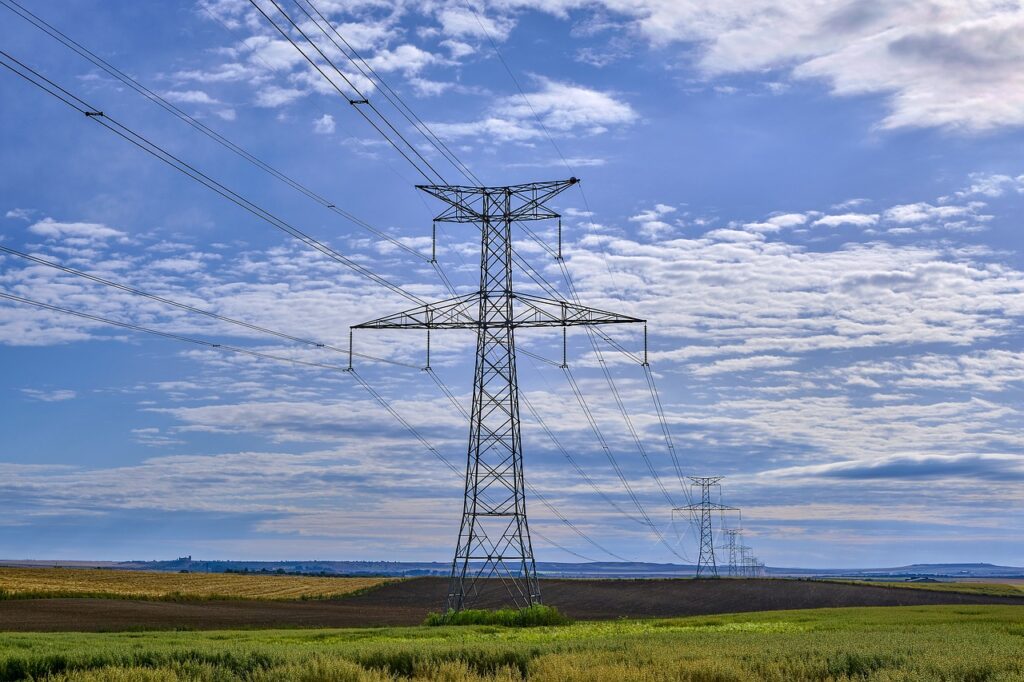
One of the marvels of modern technology is our ability to transmit electric energy over long distances. This ensures that homes, industries, and businesses get the power they need, whenever they need it.
Power Lines and Grids
- High Voltage Transmission: Electric energy is transmitted at higher voltages to reduce energy loss during transmission. For that reason high voltage ensures that electricity travels efficiently over long distances.
- Power Grids: These are interconnected networks that deliver electricity from producers to consumers. As a result they ensure a constant supply of electricity and help in distributing it evenly across regions.
Safety and Infrastructure
- Insulation: Power lines are insulated to ensure that there’s no unintentional flow of electricity. Which could be hazardous.
- Transformers: These devices step up or step down the voltage of electric energy for efficient transmission and consumption.
Innovations in Electric Energy
The field of electric energy is ever-evolving, with new technologies and innovations emerging regularly.
Clean and Green Energy
With the increasing awareness of environmental issues, there’s a significant push towards clean energy sources. Such as solar energy, wind energy, and fuel cells are examples of electrical energy sources that don’t rely on burning fossil fuels.
Electric Vehicles (EVs)
- EVs and the Environment: Electric vehicles, powered by electric motors, are a sustainable alternative to vehicles that run on gasoline or diesel. Importantly they produce zero emissions and are crucial in the fight against climate change.
- Battery Technology: The success of EVs largely depends on battery technology. Innovations in this field ensure that EVs can travel longer distances on a single charge.
FAQs (Continued)
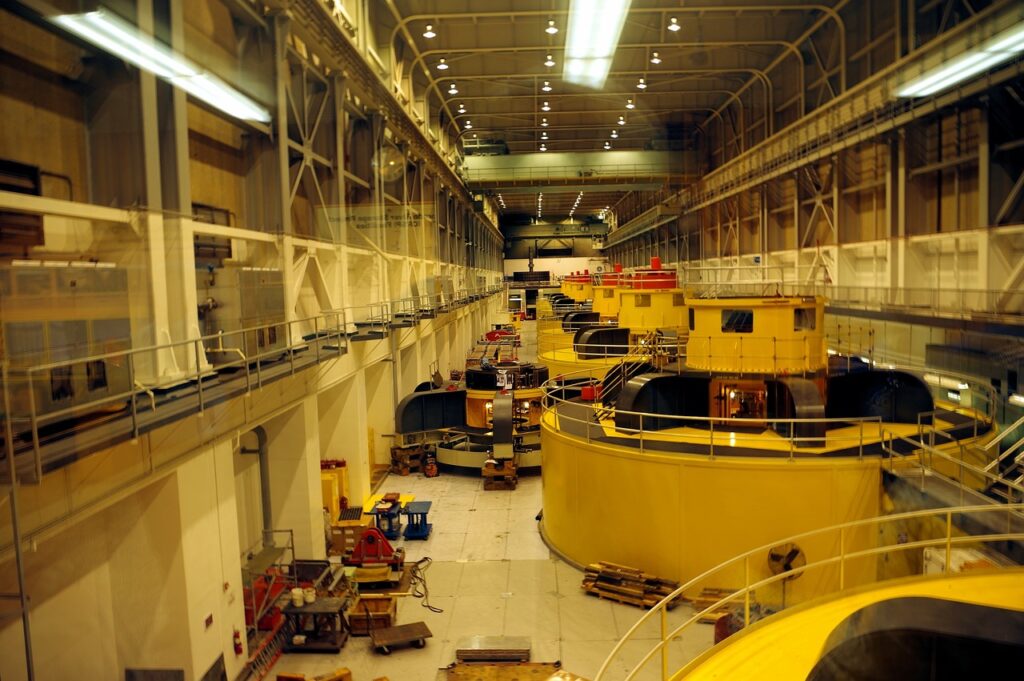
How do power plants convert primary energy sources into electric energy?
Power plants convert primary energy sources into electric energy through a series of steps:
- Energy Conversion: The primary energy source, such as coal, natural gas, nuclear fuel, wind, or sunlight, undergoes an initial energy conversion process. For fossil fuels and nuclear power, this typically involves combustion or nuclear fission, which releases thermal energy. However Renewable sources like wind and solar capture energy directly as mechanical or electrical energy.
- Heat Production: In most cases, the primary energy source generates heat. This heat is used to produce steam by heating water. In nuclear reactors, the heat is produced by nuclear fission. While in fossil fuel power plants, it comes from burning the fuel. In concentrated solar power plants, sunlight is focused to generate heat.
- Steam Generation: The generated heat is used to produce high-pressure steam in a boiler. In fact, this steam contains a significant amount of thermal energy.
- Steam Turbine: The high-pressure steam is directed through a steam turbine. As a result it passes through the turbine blades, it causes them to spin, converting thermal energy into mechanical energy.
- Generator: The spinning turbine is mechanically connected to an electric generator. Subsequently, the mechanical energy from the turbine is used to rotate the generator. Which contains coils of wire within a magnetic field. Thus this rotation induces an electric current in the coils, producing electric energy.
- Voltage Transformation: The generated electric energy is typically at a low voltage and needs to be transformed to higher voltages for efficient long-distance transmission. Transformers are used to increase the voltage. Reducing energy loss during transmission.
- Distribution: The high-voltage electricity is transmitted through power lines to substations. Where the voltage is reduced for distribution to homes, businesses, and industries.
What are the advantages of using renewable energy sources over fossil fuels?
There are several advantages to using renewable energy sources over fossil fuels:
- Environmental Benefits: Renewable energy sources produce little to no greenhouse gas emissions or air pollutants during electricity generation, helping to combat climate change and improve air quality.
- Sustainability: Renewable sources are inexhaustible over human time scales. Fossil fuels are finite resources, and their extraction can have significant environmental impacts.
- Energy Security: Relying on renewable sources reduces dependence on imported fossil fuels, enhancing energy security and reducing vulnerability to supply disruptions.
- Job Creation: The renewable energy sector has the potential to create jobs and stimulate economic growth through investments in research, development, and installation of renewable technologies.
- Reduced Energy Costs: As renewable technologies improve and scale up, the cost of electricity generation from renewables has become increasingly competitive with fossil fuels, leading to potential cost savings for consumers.
- Decentralization: Many renewable sources can be harnessed locally. Reducing the need for centralized power plants and long-distance transmission lines.
- Technological Advancements: Continued research in renewable energy can lead to technological advancements and increased efficiency, further driving down costs.
How do electric vehicles contribute to a sustainable future?
Electric vehicles (EVs) contribute to a sustainable future in several ways:
- Reduced Greenhouse Gas Emissions: EVs produce zero tailpipe emissions, reducing greenhouse gas emissions compared to traditional internal combustion engine vehicles. When charged with renewable energy, they can be nearly emissions-free.
- Energy Efficiency: Electric motors are highly efficient, converting a significant portion of electrical energy into vehicle motion. This efficiency can reduce overall energy consumption and reliance on fossil fuels.
- Energy Diversification: EVs can be charged from a variety of energy sources, including renewables. Which diversifies the energy mix and reduces dependence on oil for transportation.
- Reduced Air Pollution: EVs help improve urban air quality by eliminating emissions of pollutants like nitrogen oxides and particulate matter.
- Quiet Operation: EVs are quieter than traditional vehicles, reducing noise pollution in urban areas.
- Innovation and Job Creation: The growth of the EV industry stimulates innovation and creates jobs in manufacturing, battery technology, charging infrastructure, and related sectors.
- Grid Integration: EVs can potentially serve as grid resources, contributing stored energy back to the grid during peak demand, helping balance supply and demand.
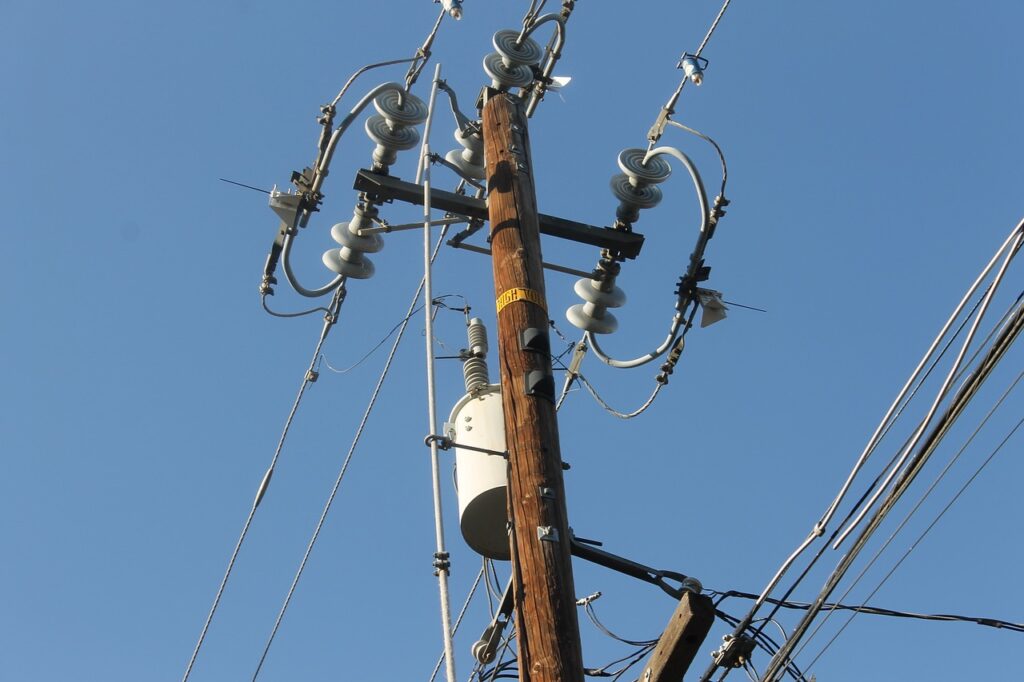
Why is the transmission of electric energy at higher voltages more efficient?
Transmitting electric energy at higher voltages is more efficient for several reasons:
- Reduced I2R Losses: When electricity flows through a conductor, there is resistance (R) in the wires, which results in heat production (I2R losses). By increasing the voltage (V), you can decrease the current (I) for a given amount of power (P = IV). Lower current reduces resistive losses, making transmission more efficient.
- Long-Distance Transmission: High-voltage transmission is essential for efficiently transporting electricity over long distances. Lower current means fewer energy losses along the power lines, enabling electricity to travel hundreds or even thousands of miles from power plants to end users.
- Smaller Wire Size: High-voltage transmission allows the use of smaller diameter wires for the same power transfer, reducing material costs and the visual impact of power lines.
- Improved Voltage Regulation: High-voltage transmission lines are better able to maintain a stable voltage level throughout the grid, ensuring consistent and reliable electricity supply to consumers.
- Flexibility in Grid Operation: High-voltage transmission systems provide greater flexibility for grid operators to route electricity where it is needed most, enhancing grid reliability and resilience.
Understanding the intricacies of electric energy, from its basic principles to its modern applications, is crucial in today’s world. So as we continue to rely more on electric energy, innovations and sustainable practices will shape the future of this indispensable resource.
The Evolution of Electric Energy
The journey of electric energy, from its discovery to its modern-day applications, is a testament to human ingenuity and perseverance. Moreover the contributions of pioneers like Benjamin Franklin, Michael Faraday, and Thomas Edison have paved the way for the electric world we live in today.
Historical Milestones
- Benjamin Franklin’s Kite Experiment: In the 18th century, Franklin’s famous kite experiment demonstrated the existence of electricity in the atmosphere, laying the groundwork for understanding static electricity.
- Michael Faraday’s Discoveries: Faraday’s experiments in the 19th century on electromagnetic induction led to the development of the electric generator, a device that converts mechanical energy into electric energy.
- Thomas Edison and the Light Bulb: While Edison didn’t invent the light bulb, his design was the first commercially viable one, bringing electric light to homes and businesses.
Challenges and Solutions in Electric Energy
As the demand for electric energy grows, so do the challenges associated with its generation, distribution, and consumption. But addressing these challenges requires innovative solutions and forward-thinking strategies.
Energy Storage
- Battery Technology: Advanced battery technologies allow for more efficient storage of electric energy, making renewable energy sources like solar and wind more viable.
- Grid Energy Storage: Large-scale energy storage solutions, such as pumped hydro storage, ensure that excess energy generated during peak times is stored and used during periods of high demand.
Sustainability and Environmental Concerns
- Transition to Renewable Energy: Moving away from fossil fuels and embracing renewable energy sources reduces carbon emissions and combats climate change.
- Energy Efficiency: Implementing energy-efficient practices and technologies reduces energy consumption and waste, leading to a more sustainable future.
The Future of Electric Energy
Indeed the horizon of electric energy is bright, with technological advancements and sustainable practices shaping its future.
Smart Grids
- Adaptive and Responsive: Smart grids use digital technology to monitor and respond to changes in electricity usage, ensuring a more efficient and reliable power supply.
- Integration with Renewable Energy: Smart grids can seamlessly integrate with renewable energy sources, optimizing energy distribution based on demand and availability.
Electrification of Transportation
- High-speed Electric Trains: Electric trains, capable of speeds matching or even surpassing conventional trains, offer a faster and more environmentally friendly mode of transportation.
- Electric Aviation: While still in its infancy, the concept of electric planes could revolutionize air travel, reducing emissions and noise pollution.
FAQs (Continued)
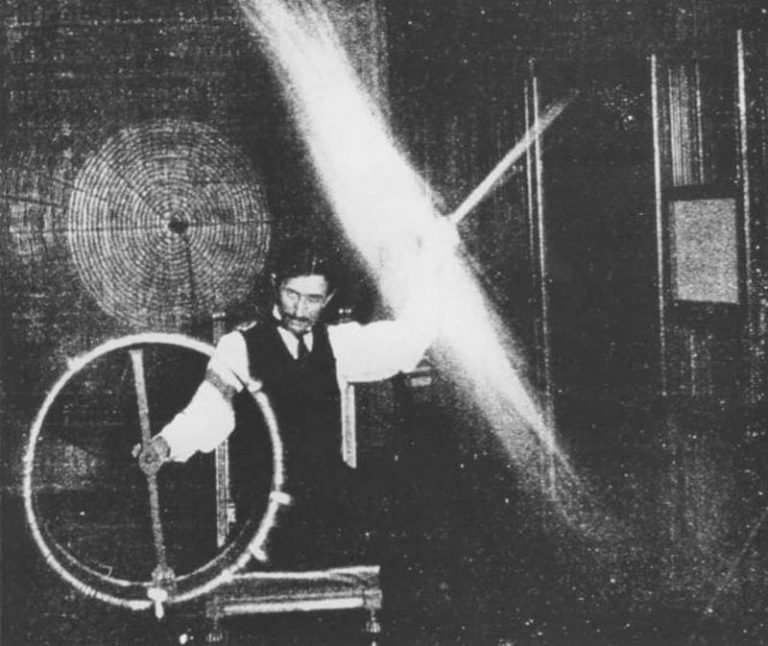
How have historical figures influenced the development of electric energy?
Historical figures have played crucial roles in shaping the development of electric energy. Some key individuals and their contributions include:
- Benjamin Franklin: His experiments with lightning and static electricity in the 18th century laid the groundwork for understanding electricity’s fundamental principles.
- Michael Faraday: His work on electromagnetic induction in the 19th century led to the development of electric generators, which are essential for generating electric energy.
- Thomas Edison: Edison’s inventions, including the incandescent light bulb and the development of direct current (DC) power systems, helped pioneer the practical use of electric energy for lighting and early power distribution.
- Nikola Tesla: Tesla’s work on alternating current (AC) systems, transformers, and polyphase power laid the foundation for modern electric power distribution and transmission.
- Charles Steinmetz: Steinmetz’s contributions to understanding alternating current behavior and electrical engineering principles were instrumental in making AC power systems efficient and practical.
- Samuel Insull: Insull played a key role in the expansion and standardization of electric utility companies, making electricity more widely available to the public.
- Today’s Innovators: Contemporary figures and engineers continue to advance electric energy technologies, with contributions to renewable energy, energy storage, and grid modernization.
These historical figures and many others have collectively shaped the development and widespread adoption of electric energy, from its early scientific discoveries to its practical application in modern society.
What are the primary challenges faced by the electric energy sector today?
The electric energy sector faces several significant challenges:
- Transition to Renewable Energy: Transitioning from fossil fuels to renewable energy sources while maintaining grid reliability is a major challenge. Integrating variable renewable sources like wind and solar into the grid requires advanced grid management and energy storage solutions.
- Aging Infrastructure: Much of the existing power grid infrastructure is aging and in need of modernization to improve efficiency and reliability. Upgrading the grid is a costly and complex endeavor.
- Cybersecurity: As the grid becomes more interconnected and reliant on digital technologies, it becomes increasingly vulnerable to cyberattacks. Ensuring the security of critical infrastructure is paramount.
- Energy Storage: Developing cost-effective energy storage solutions, such as advanced batteries, is essential for balancing supply and demand and optimizing the use of renewable energy.
- Grid Resilience: Building resilience against natural disasters, extreme weather events, and other disruptions is crucial to prevent widespread power outages.
- Regulatory and Policy Challenges: Complex regulations and policies at the local, state, and national levels can impact grid modernization and the deployment of new technologies.
- Electrification of Transportation: The growing demand for electric vehicles places additional stress on the grid. Ensuring that the grid can accommodate increased electric vehicle charging is a challenge.
Indeed addressing these challenges is vital to creating a sustainable, reliable, and efficient electric energy sector for the future.
How do smart grids differ from traditional power grids?
Smart grids differ from traditional power grids in several ways:
- Two-Way Communication: Smart grids use advanced communication technology to enable two-way communication between utilities and consumers. This allows for real-time data exchange, such as electricity usage information, outage alerts, and pricing data.
- Remote Monitoring and Control: Smart grids use sensors and automation to monitor grid conditions, detect faults, and reroute electricity to minimize downtime. This improves reliability and reduces response times to outages.
- Distributed Energy Resources (DERs): Smart grids seamlessly integrate distributed energy resources like solar panels, wind turbines, and energy storage systems. These resources can generate electricity locally and even feed excess power back into the grid.
- Demand Response: Smart grids enable demand response programs that allow consumers to adjust their electricity usage in response to price signals or grid conditions. This helps balance supply and demand more efficiently.
- Improved Efficiency: With real-time data and analytics, smart grids optimize the distribution of electricity, reducing energy losses and improving overall grid efficiency.
- Grid Resilience: Smart grids are designed to be more resilient against disruptions. Including natural disasters and cyberattacks, thanks to advanced monitoring and control capabilities.
- Enhanced Sustainability: By integrating renewable energy sources and enabling energy conservation through demand-side management, smart grids contribute to a more sustainable energy system.
Smart grids represent a significant advancement over traditional power grids by leveraging digital technology and data to enhance efficiency, reliability, and sustainability in the delivery of electric energy.
In conclusion, electric energy, with its rich history and promising future, continues to be a driving force in the advancement of human civilization. As we move towards a more sustainable and technologically advanced future, electric energy will undoubtedly play a pivotal role in shaping the world of tomorrow.

What role will electric energy play in the future of transportation?
Electric energy is poised to play a pivotal role in the future of transportation for several reasons:
- Electric Vehicles (EVs): The widespread adoption of electric vehicles is reducing the transportation sector’s reliance on fossil fuels and lowering greenhouse gas emissions.
- Cleaner Mobility: EVs produce zero tailpipe emissions, improving air quality and reducing the environmental impact of transportation.
- Efficiency: Electric motors are highly efficient, converting a significant portion of electrical energy into vehicle motion. This can reduce energy consumption compared to internal combustion engine vehicles.
- Renewable Energy Integration: EVs can be charged using electricity from renewable sources. Further reducing their carbon footprint and aligning with sustainable energy goals.
- Grid Integration: As the number of EVs grows, they can serve as grid resources by storing excess energy and feeding it back into the grid during peak demand, helping to balance supply and demand.
- Innovation: Ongoing research and development in battery technology are expected to lead to longer-range EVs. Faster charging times, and reduced costs, making EVs even more attractive to consumers.
- Transportation Electrification: Beyond passenger vehicles, electric energy will likely play a role in electrifying public transit, commercial fleets, and even aviation, contributing to a cleaner and more sustainable transportation sector.
Electric energy is central to efforts to reduce the environmental impact of transportation and transition to more sustainable mobility solutions in the future.
Diverse Applications of Electric Energy
Electric energy’s versatility is evident in its wide range of applications, from everyday household tasks to cutting-edge technological innovations.
In the Home
- Household Appliances: Refrigerators, washing machines, air conditioners, and ovens are just a few examples of electrical appliances that have transformed domestic life.
- Entertainment and Communication: Televisions, computers, smartphones, and other electronic devices rely on electric energy to function, connecting us to the world and providing endless entertainment.
Medical Field
- Medical Equipment: Devices like X-ray machines, MRI scanners, and defibrillators are powered by electric energy. Playing a crucial role in diagnostics and treatment.
- Research and Development: Laboratories utilize electric energy for research, leading to medical breakthroughs and innovations.
Electric Energy and the Environment
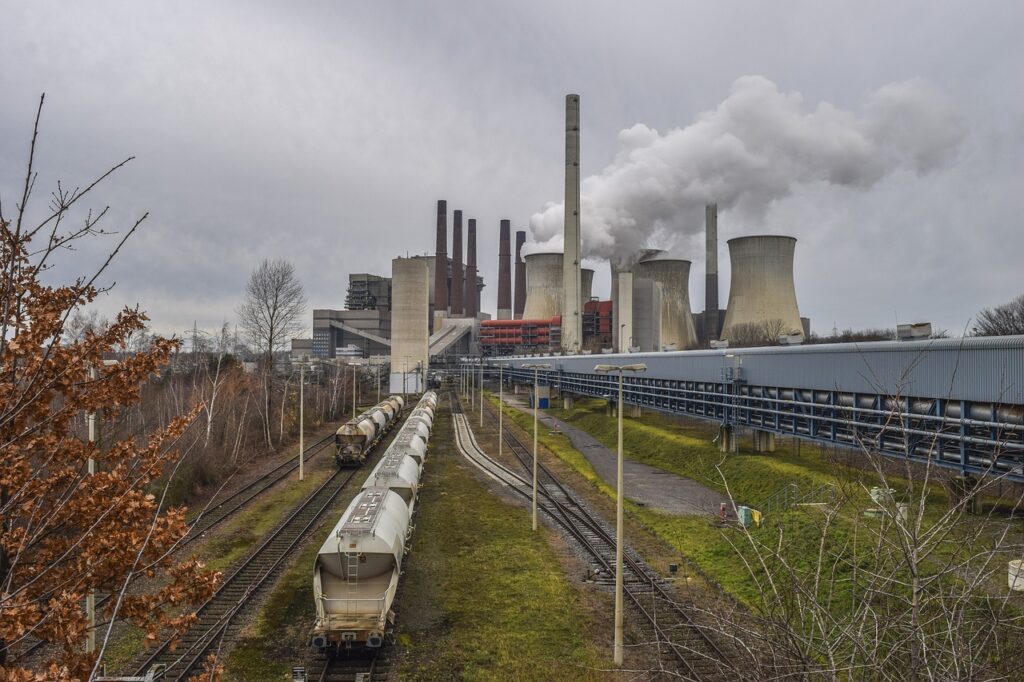
The relationship between electric energy and the environment is multifaceted, with both challenges and opportunities for a sustainable future.
Environmental Impact
- Carbon Footprint: Traditional power plants, especially those burning fossil fuels, release significant amounts of carbon dioxide, contributing to global warming.
- Habitat Disruption: Building large-scale power plants, especially hydroelectric dams, can disrupt local ecosystems and wildlife habitats.
Sustainable Solutions
- Green Energy: Harnessing renewable energy sources like solar, wind, and hydro reduces the carbon footprint. So in the long run it becomes more sustainable.
- Conservation and Efficiency: Adopting energy-efficient practices and technologies can significantly reduce electricity consumption, benefiting both the environment and consumers.
The Economic Aspects of Electric Energy
Electric energy is not just a scientific or environmental topic; it has profound economic implications as well.
Job Creation
- Renewable Energy Sector: The rise of renewable energy sources has led to the creation of numerous jobs in manufacturing, installation, and maintenance.
- Research and Development: Investment in electric energy research opens up opportunities for scientists, engineers, and technicians.
Economic Growth
- Infrastructure Development: Building power plants, transmission lines, and other infrastructure drives economic growth by creating jobs and stimulating local economies.
- Global Trade: Electric energy plays a role in global trade, with countries exporting and importing energy resources and technologies.
FAQs (Continued)
How does electric energy impact the environment?
Electric energy can have both positive and negative environmental impacts:
- Positive Impacts:
- Reduced Emissions: When generated from renewable sources like wind, solar, or hydropower, electric energy can produce little to no greenhouse gas emissions or air pollutants, reducing its negative impact on the environment.
- Efficiency: Electric motors are highly efficient, which can lead to energy savings in various applications, from transportation to industrial processes.
- Negative Impacts:
- Fossil Fuels: If electric energy is primarily generated from fossil fuels. Like coal or natural gas, it can contribute to air pollution. Greenhouse gas emissions, and habitat destruction associated with mining and extraction.
- Resource Consumption: The production and disposal of batteries used in electric vehicles and energy storage can have environmental impacts, depending on the materials used and recycling practices.
- Habitat Disruption: Hydropower dams can disrupt ecosystems and alter water flow patterns, impacting aquatic life and habitats.
Overall, the environmental impact of electric energy depends on how it is generated, stored, and used. Transitioning to cleaner and more sustainable energy sources can significantly reduce these negative environmental effects.

What are the economic benefits of transitioning to renewable energy sources?
Transitioning to renewable energy sources can yield several economic benefits:
- Job Creation: The renewable energy sector, including the manufacturing, installation, and maintenance of renewable energy technologies, can create jobs, stimulate economic growth, and support local communities.
- Energy Cost Savings: Renewable energy sources often have lower operating and maintenance costs compared to fossil fuels. This can lead to reduced energy costs for consumers and businesses.
- Reduced Fuel Price Volatility: Renewable energy sources are not subject to the price fluctuations seen in fossil fuel markets. Providing stability and predictability in energy costs.
- Energy Independence: Relying on domestic renewable resources reduces dependence on imported fossil fuels. Enhancing energy security and reducing exposure to geopolitical risks.
- Technological Innovation: Investment in renewable energy technologies fosters innovation and research, leading to advancements in energy efficiency and the development of new industries.
- Environmental Savings: By mitigating climate change and reducing air pollution, the transition to renewables can lower healthcare costs associated with treating respiratory and cardiovascular diseases.
- Competitive Advantage: Businesses that adopt renewable energy and sustainable practices may gain a competitive edge in a market increasingly focused on sustainability.
Specifically these economic benefits make the transition to renewable energy sources an attractive option for governments, businesses, and individuals seeking long-term economic stability and sustainability.
How has electric energy influenced modern medical practices?
Electric energy has revolutionized modern medical practices in several ways:
- Medical Devices: Electric energy powers a wide range of medical devices. Including X-ray machines, MRI scanners, electrocardiographs (ECGs), defibrillators, and ventilators. These devices enable accurate diagnosis and treatment of various medical conditions.
- Surgical Tools: Surgical tools use electrical energy. Such as electrocautery devices, lasers, and robotic surgical systems. These tools enhance the precision and effectiveness of surgeries.
- Life Support Systems: Electrically powered life support systems, including pacemakers, artificial hearts, and dialysis machines, extend and improve the quality of life for patients with chronic conditions.
- Diagnostic Imaging: Electric energy enables the generation of high-quality diagnostic images. Such as CT scans and ultrasounds, aiding in the detection and monitoring of diseases.
- Research and Development: Electric energy powers laboratories and research facilities, enabling medical researchers to conduct experiments, analyze data, and develop new treatments and therapies.
- Telemedicine: The use of electric energy in telecommunications technology has facilitated telemedicine. Allowing remote consultations and healthcare delivery, especially in underserved or remote areas.
- Data Management: Electric energy supports the storage and analysis of vast amounts of medical data. Enabling advancements in personalized medicine and data-driven healthcare decision-making.
In essence, electric energy plays a foundational role in the functioning of modern healthcare systems. Contributing to improved patient care, medical advancements, and the overall well-being of individuals.
What role does electric energy play in global economics and trade?
Electric energy plays a critical role in global economics and trade for several reasons:
- Industrial Production: Electric energy is essential for industrial processes, manufacturing, and the operation of machinery and equipment. Industries often rely on electricity to increase productivity and competitiveness.
- Commercial and Residential Use: Businesses and households worldwide depend on electric energy for lighting, heating, cooling, electronic devices, and more. Access to reliable electricity is a fundamental aspect of modern living and economic activity.
- Transportation: Electric energy is increasingly used in transportation. Particularly with the growth of electric vehicles (EVs). The automotive industry’s shift toward electrification has global economic implications.
- International Energy Trade: Countries may export or import electricity depending on their energy resources and needs. Cross-border energy trade can strengthen economic ties between nations.
- Energy-Intensive Industries: Energy-intensive industries like data centers, mining, and metallurgy have a significant impact on global energy demand and trade. Affecting energy markets and prices.
- Renewable Energy Exports: Some countries export renewable energy technologies, components, and expertise. Contributing to the global renewable energy market and economic development.
- Geopolitical Influence: Access to and control over energy resources and infrastructure can influence geopolitics and international relations.
Electric energy is a foundational element of modern economies and a driver of global trade. Making it a key consideration in economic development and international diplomacy.
Finally to wrap up this segment, electric energy’s influence extends far beyond powering devices. Also it shapes economies, drives technological advancements, impacts the environment. And plays a pivotal role in various sectors, from healthcare to communication. As we continue to harness and understand electric energy, its significance in shaping a sustainable and prosperous future becomes even more evident.
The Global Landscape of Electric Energy
Electric energy is a global commodity, with countries around the world harnessing its power for development, growth, and sustainability.
Global Energy Consumption
- Rising Demand: As developing nations industrialize and urbanize, their demand for electric energy surges. Leading to increased pressure on energy resources.
- Diverse Energy Portfolios: Different countries have varied energy portfolios, with some relying heavily on fossil fuels, while others invest significantly in renewables.
International Collaborations
- Shared Resources: Countries with abundant energy resources often export to neighboring nations, fostering economic ties and mutual benefits.
- Joint Research Initiatives: Nations collaborate on research projects, pooling resources and expertise to drive innovations in electric energy.
Challenges in Electric Energy Accessibility

While many of us take electricity for granted, a significant portion of the global population still lacks access to reliable electricity.
Energy Poverty
- Rural Areas: Many remote and rural regions, especially in developing countries, remain off the grid. Depriving residents of the benefits of electric energy.
- Affordability: Even in areas with electricity, the cost can be prohibitive for many, leading to energy poverty.
Solutions and Initiatives
- Microgrids: Small-scale, localized energy grids can provide electricity to remote areas, often harnessing renewable sources like solar or wind.
- Subsidies and Financial Support: Governments and NGOs offer financial support to make electric energy more affordable for underserved populations.
The Ethical Dimensions of Electric Energy
The production and consumption of electric energy come with ethical considerations, especially concerning environmental impact and social justice.
Environmental Ethics
- Sustainable Practices: Prioritizing renewable energy sources over fossil fuels is not just an economic or environmental decision but an ethical one, considering the long-term health of the planet.
- Biodiversity: Large-scale energy projects, like dams, can threaten local ecosystems. Ethical considerations demand a balance between development and conservation.
Social Justice and Energy
- Equitable Distribution: Ensuring that all communities, regardless of economic status, have access to reliable electric energy is a matter of social justice.
- Worker Rights: The rights and safety of workers in the energy sector, especially in mining and power plants, must be upheld to ethical standards.
FAQs (Continued)
What is energy poverty, and how does it impact communities?
Energy poverty refers to the lack of access to modern energy services. Including electricity and clean cooking facilities, by a significant portion of the population. It impacts communities in several ways:
- Health: Lack of access to clean cooking facilities leads to indoor air pollution. Which can result in respiratory diseases, particularly affecting women and children who spend more time indoors.
- Education: Insufficient access to electricity can hinder educational opportunities. Because students may struggle to study in the dark or lack access to technology for remote learning.
- Economic Development: Energy poverty limits economic growth, as industries, businesses, and agriculture often rely on electricity for production and operations.
- Gender Disparities: Women and girls are disproportionately affected by energy poverty. As they are often responsible for household energy needs and may spend significant time collecting traditional fuels.
- Environmental Impact: In regions with energy poverty, people may resort to unsustainable and environmentally harmful energy sources, exacerbating deforestation and contributing to climate change.
Finally, addressing energy poverty involves expanding access to reliable and affordable electricity, promoting clean cooking solutions, and improving energy efficiency. Moreover it can lead to improved living conditions, health, education, and economic opportunities for communities.
How do countries collaborate on electric energy projects and research?
Countries collaborate on electric energy projects and research through various mechanisms, including:
- Bilateral Agreements: Two countries may enter into agreements to jointly develop energy projects, share expertise, or collaborate on research initiatives. Besides these agreements can involve electricity trade, infrastructure development, and technology transfer.
- Multilateral Organizations: Many international organizations, such as the International Energy Agency (IEA) and the United Nations, facilitate cooperation among countries in the field of energy. They provide platforms for sharing best practices, data, and research findings.
- Regional Initiatives: Neighboring countries often collaborate within regional frameworks. Chiefly to develop cross-border electricity transmission projects, harmonize energy policies, and enhance energy security.
- Research Partnerships: Universities, research institutions, and energy companies from different countries frequently collaborate on research projects related to electric energy. In fact this can involve joint funding, data sharing, and knowledge exchange.
- International Conferences and Forums: Global events and forums provide opportunities for countries to discuss energy challenges, exchange ideas, and explore potential partnerships. These include events like the World Energy Congress and COP (Conference of the Parties) meetings.
Consequently collaborative efforts help countries leverage their resources, share expertise, and address common energy challenges more effectively. They are especially important in advancing clean and sustainable energy solutions on a global scale.
What are the ethical considerations in electric energy production and consumption?
Ethical considerations in electric energy production and consumption encompass several key areas:
- Environmental Impact: The environmental ethics of energy production involve minimizing harm to ecosystems. Reducing greenhouse gas emissions, and mitigating climate change. Hence sustainable and clean energy sources are often favored for ethical reasons.
- Health and Well-being: Ethical concerns related to energy production include protecting human health from pollution. And also addressing energy-related health disparities, and ensuring access to reliable energy for basic needs.
- Social Equity: Equity and justice considerations involve ensuring that the benefits and burdens of energy production and consumption are distributed fairly among different communities. Especially vulnerable populations.
- Resource Allocation: Ethical discussions include how energy resources are allocated and used. Particularly in contexts where energy is scarce or expensive.
- Transparency and Accountability: Ethical practices in the energy sector require transparency in decision-making, accountability for environmental and social impacts, and responsible management of energy infrastructure.
- Inter-generational Equity: There is a moral obligation to consider the needs of future generations in energy choices. Chiefly including the preservation of natural resources and the reduction of long-term environmental harm.
- Cultural Considerations: In some cases, energy projects may impact cultural heritage sites or indigenous communities. Therefore ethical considerations include respecting cultural values and ensuring the consent and involvement of affected communities.
Consequently addressing these ethical considerations often involves a balance between the need for reliable energy to support economic development and the moral imperative to minimize harm to the environment, promote social equity, and protect human well-being.
How can we ensure that electric energy is accessible and affordable for all?
Ensuring universal access to affordable electric energy requires a multifaceted approach:
- Infrastructure Development: Invest in expanding electricity infrastructure, particularly in underserved and rural areas, to bring reliable power to more communities.
- Financial Support: Implement subsidies, incentives, or financial assistance programs to make electricity more affordable for low-income households.
- Energy Efficiency: Promote energy efficiency measures to reduce energy consumption and lower electricity bills for consumers.
- Clean Cooking Solutions: Address energy poverty by providing clean and affordable cooking solutions. Reducing the reliance on traditional and polluting cooking methods.
- Renewable Energy: Develop and promote renewable energy sources, which can be cost-effective and environmentally friendly, especially in remote areas.
- Microgrids: Deploy microgrid systems that can provide electricity to isolated or off-grid communities. Thus, reducing the need for costly long-distance transmission lines.
- Community Engagement: Involve local communities in the planning and decision-making processes related to energy projects to ensure their needs and concerns are addressed.
- Regulatory Reforms: Implement effective regulations that encourage competition, drive down costs, and protect consumers’ interests.
- International Aid: Support from international organizations and donor countries can help finance electrification projects in developing nations.
Ensuring universal and affordable access to electric energy is not only a matter of basic human rights. But also a critical component of sustainable development and poverty reduction efforts. However it requires a coordinated effort by governments, NGOs, the private sector, and international partners.
In conclusion, electric energy, while a powerful tool for development and progress, comes with its set of challenges and responsibilities. In conclusion as we navigate the complexities of the global energy landscape, it’s crucial to approach the topic with a holistic perspective, considering economic, environmental, and ethical dimensions. By doing so, we can ensure a brighter and more sustainable future for all.
Recent Posts
Understanding Energy and Electricity: The Power For Progress
Energy and Electricity Energy and electricity are integral components of modern life, powering everything from homes and businesses to transportation and communication. Without them, the...
The Future of Wind Energy The future of wind energy is set to play a critical role in addressing global energy needs while combating climate change. As renewable energy sources like wind and...


